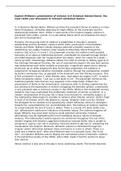Explore Williams's presentation of violence in A Streetcar Named Desire. You
must relate your discussion to relevant contextual factors
In ‘A Streetcar Named desire, Williams portrays the prevalent theme of violence in many
forms throughout, ultimately depicting its tragic effects on the characters and the
relationships between them. Whilst in some parts of the modern tragedy violence is
presented more subtly, overall, it is a pervading theme which encompasses the play’s
plot and its development.
Primarily, the recurring motif of violence is established in the play’s romantic
relationships and the domestic violence within them, particularly in that between
Stanley and Stella. Williams initially displays potential unhealthy aspects of the
relationship very subtly, however, later reveals its disturbing nature through the
violence that occurs. In scene 1, the playwright provides the audience with possible
indicators of an abusive relationship dynamic, manifested for example through Stella’s
one-sided obsession with her husband when she states, ‘when he’s away for a week I
nearly go wild!’ Interestingly, Williams utilises the motif of animals to display aspects of
the marriage throughout the play; the use of zoomorphism depicts the way both parties
may dehumanise each other verbally or physically- a significant aspect that a director
would pick up on when staging the play. As the play progresses, the audience is
subjected to increasing indicators of possible violence through the juxtaposition created
by stella’s submissive role, as opposed to the dominant one that Stanley assumes. This
is first conveyed in Scene 2, when Stanley asks, ‘How about my supper, huh?’, to which
Stella compliantly replies, ‘I put you a cold plate on ice’. The playwright reinforces the
traditional gender roles that are very apparent in the relationship. Indeed, the
presentation of Stella as the stereotypical ‘submissive wife’ to Stanley emphasises her
succumbing to the expectation of women navigating the domestic sphere; contextually
a very prevalent idea in American society in the 1950s. Whilst a mid-nineteenth century
audience may have overlooked this problematic treatment of women as inferior, in a
modern interpretation of the play this is likely to be focused on. Unhealthy aspects of
the relationship slowly begin to escalate to violence when Stanley ‘whacks’ stella’s thigh
in front of his friends, which she objects to, saying ‘(sharply): that’s not fun, Stanley’.
His disregard for her protest to his possessively violent behaviour elicits his disrespect
towards her, exacerbated by her uncomfortable tone. The build-up of violence reaches
its climax towards the end of scene 3, where ‘There is a sound of a blow. Stella cries
out’, affirming the subtle prior indicators of domestic abuse. The violence happens off
stage; Williams may have been trying to avoid potential censorship, however,
alternatively may be highlighting the not immediately obvious nature of domestic
violence. The relationship’s violent aspects are reinforced throughout the rest of the
modern tragedy with Stanley’s aggressive behaviour towards Stella, who is unable to
recognise it, saying ‘I am not in anything I have the desire to get out of’, presenting the
manipulation she endures. Moreover, domestic violence is illustrated through the
singular violent altercation between Steve and Eunice in scene 5, where ‘There is a
crash and a relative hush’, after which Blanche asks in a sarcastic tone: ’Did he kill
her?’; an indicator Williams uses to display the normalised nature of domestic violence
in the patriarchal society of the 1950s, which often made it hard for women to leave
their partner.
Verbal violence is also one of the play’s many underlying motifs. The theme becomes




